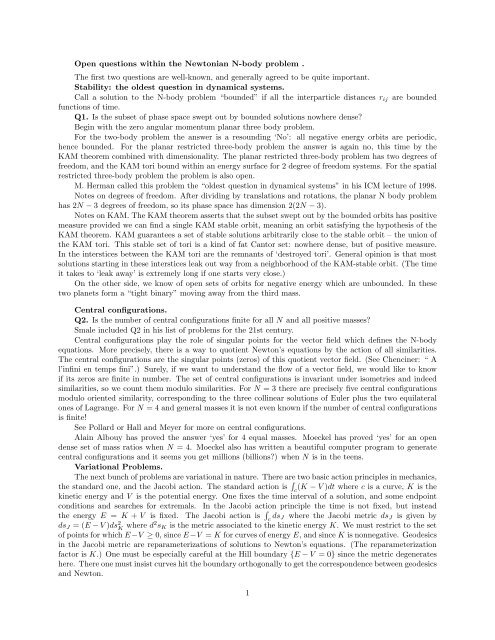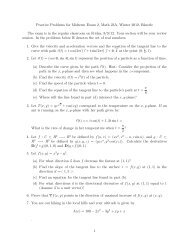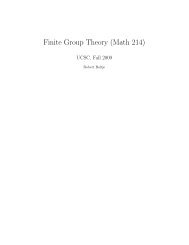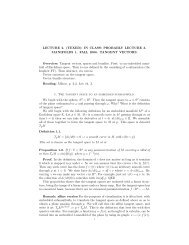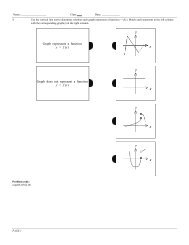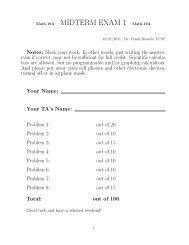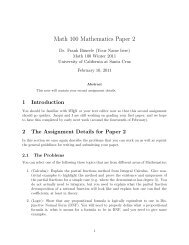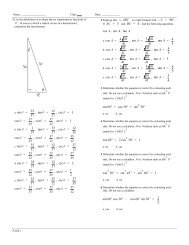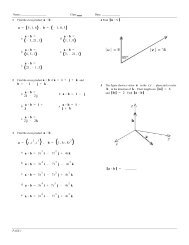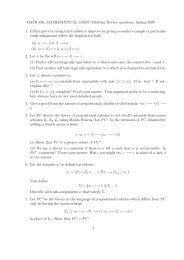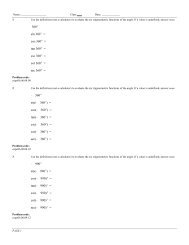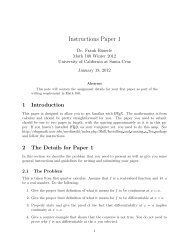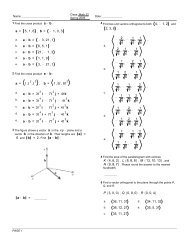Open questions within the Newtonian N-body problem . The first two ...
Open questions within the Newtonian N-body problem . The first two ...
Open questions within the Newtonian N-body problem . The first two ...
Create successful ePaper yourself
Turn your PDF publications into a flip-book with our unique Google optimized e-Paper software.
<strong>Open</strong> <strong>questions</strong> <strong>within</strong> <strong>the</strong> <strong>Newtonian</strong> N-<strong>body</strong> <strong>problem</strong> .<br />
<strong>The</strong> <strong>first</strong> <strong>two</strong> <strong>questions</strong> are well-known, and generally agreed to be quite important.<br />
Stability: <strong>the</strong> oldest question in dynamical systems.<br />
Call a solution to <strong>the</strong> N-<strong>body</strong> <strong>problem</strong> “bounded” if all <strong>the</strong> interparticle distances r ij are bounded<br />
functions of time.<br />
Q1. Is <strong>the</strong> subset of phase space swept out by bounded solutions nowhere dense?<br />
Begin with <strong>the</strong> zero angular momentum planar three <strong>body</strong> <strong>problem</strong>.<br />
For <strong>the</strong> <strong>two</strong>-<strong>body</strong> <strong>problem</strong> <strong>the</strong> answer is a resounding ‘No’: all negative energy orbits are periodic,<br />
hence bounded. For <strong>the</strong> planar restricted three-<strong>body</strong> <strong>problem</strong> <strong>the</strong> answer is again no, this time by <strong>the</strong><br />
KAM <strong>the</strong>orem combined with dimensionality. <strong>The</strong> planar restricted three-<strong>body</strong> <strong>problem</strong> has <strong>two</strong> degrees of<br />
freedom, and <strong>the</strong> KAM tori bound <strong>within</strong> an energy surface for 2 degree of freedom systems. For <strong>the</strong> spatial<br />
restricted three-<strong>body</strong> <strong>problem</strong> <strong>the</strong> <strong>problem</strong> is also open.<br />
M. Herman called this <strong>problem</strong> <strong>the</strong> “oldest question in dynamical systems” in his ICM lecture of 1998.<br />
Notes on degrees of freedom. After dividing by translations and rotations, <strong>the</strong> planar N <strong>body</strong> <strong>problem</strong><br />
has 2N − 3 degrees of freedom, so its phase space has dimension 2(2N − 3).<br />
Notes on KAM. <strong>The</strong> KAM <strong>the</strong>orem asserts that <strong>the</strong> subset swept out by <strong>the</strong> bounded orbits has positive<br />
measure provided we can find a single KAM stable orbit, meaning an orbit satisfying <strong>the</strong> hypo<strong>the</strong>sis of <strong>the</strong><br />
KAM <strong>the</strong>orem. KAM guarantees a set of stable solutions arbitrarily close to <strong>the</strong> stable orbit – <strong>the</strong> union of<br />
<strong>the</strong> KAM tori. This stable set of tori is a kind of fat Cantor set: nowhere dense, but of positive measure.<br />
In <strong>the</strong> interstices between <strong>the</strong> KAM tori are <strong>the</strong> remnants of ‘destroyed tori’. General opinion is that most<br />
solutions starting in <strong>the</strong>se interstices leak out way from a neighborhood of <strong>the</strong> KAM-stable orbit. (<strong>The</strong> time<br />
it takes to ‘leak away’ is extremely long if one starts very close.)<br />
On <strong>the</strong> o<strong>the</strong>r side, we know of open sets of orbits for negative energy which are unbounded. In <strong>the</strong>se<br />
<strong>two</strong> planets form a “tight binary” moving away from <strong>the</strong> third mass.<br />
Central configurations.<br />
Q2. Is <strong>the</strong> number of central configurations finite for all N and all positive masses?<br />
Smale included Q2 in his list of <strong>problem</strong>s for <strong>the</strong> 21st century.<br />
Central configurations play <strong>the</strong> role of singular points for <strong>the</strong> vector field which defines <strong>the</strong> N-<strong>body</strong><br />
equations. More precisely, <strong>the</strong>re is a way to quotient Newton’s equations by <strong>the</strong> action of all similarities.<br />
<strong>The</strong> central configurations are <strong>the</strong> singular points (zeros) of this quotient vector field. (See Chenciner: “ A<br />
l’infini en temps fini”.) Surely, if we want to understand <strong>the</strong> flow of a vector field, we would like to know<br />
if its zeros are finite in number. <strong>The</strong> set of central configurations is invariant under isometries and indeed<br />
similarities, so we count <strong>the</strong>m modulo similarities. For N =3<strong>the</strong>re are precisely five central configurations<br />
modulo oriented similarity, corresponding to <strong>the</strong> three collinear solutions of Euler plus <strong>the</strong> <strong>two</strong> equilateral<br />
ones of Lagrange. For N =4and general masses it is not even known if <strong>the</strong> number of central configurations<br />
is finite!<br />
See Pollard or Hall and Meyer for more on central configurations.<br />
Alain Albouy has proved <strong>the</strong> answer ‘yes’ for 4 equal masses. Moeckel has proved ‘yes’ for an open<br />
dense set of mass ratios when N =4. Moeckel also has written a beautiful computer program to generate<br />
central configurations and it seems you get millions (billions?) when N is in <strong>the</strong> teens.<br />
Variational Problems.<br />
<strong>The</strong> next bunch of <strong>problem</strong>s are variational in nature. <strong>The</strong>re are <strong>two</strong> basic action principles in mechanics,<br />
<strong>the</strong> standard one, and <strong>the</strong> Jacobi action. <strong>The</strong> standard action is ∫ (K − V )dt where c is a curve, K is <strong>the</strong><br />
c<br />
kinetic energy and V is <strong>the</strong> potential energy. One fixes <strong>the</strong> time interval of a solution, and some endpoint<br />
conditions and searches for extremals. In <strong>the</strong> Jacobi action principle <strong>the</strong> time is not fixed, but instead<br />
<strong>the</strong> energy E = K + V is fixed. <strong>The</strong> Jacobi action is ∫ c ds J where <strong>the</strong> Jacobi metric ds J is given by<br />
ds J =(E − V )ds 2 K where d2 s K is <strong>the</strong> metric associated to <strong>the</strong> kinetic energy K. Wemust restrict to <strong>the</strong> set<br />
of points for which E−V ≥ 0, since E−V = K for curves of energy E, and since K is nonnegative. Geodesics<br />
in <strong>the</strong> Jacobi metric are reparameterizations of solutions to Newton’s equations. (<strong>The</strong> reparameterization<br />
factor is K.) One must be especially careful at <strong>the</strong> Hill boundary {E − V =0} since <strong>the</strong> metric degenerates<br />
here. <strong>The</strong>re one must insist curves hit <strong>the</strong> boundary orthogonally to get <strong>the</strong> correspondence between geodesics<br />
and Newton.<br />
1
It is well-known that a collision-free local minimizer of <strong>the</strong> action is a solution, provided we put appropriate<br />
endpoint conditions on <strong>the</strong> competing class of curves. <strong>The</strong> collisions are <strong>the</strong> central difficulty in using<br />
ei<strong>the</strong>r action principle. <strong>The</strong> Hill boundary is an additional difficulty with <strong>the</strong> Jacobi action.<br />
A priori, all we know about a minimizer for <strong>the</strong> standard action is that it consists of a countable<br />
collection of solution arcs concatenated continuously at collisions. <strong>The</strong> set of collision times could be any<br />
closed set of measure zero, eg. <strong>the</strong> Cantor set.<br />
In this regard <strong>the</strong> following <strong>the</strong>orem is fundamental.<br />
<strong>The</strong>orem. (Chenciner, 2002 ICM) For <strong>the</strong> fixed endpoint <strong>problem</strong> with collision-free endpoints, and for <strong>the</strong><br />
standard action for <strong>the</strong> N-<strong>body</strong> <strong>problem</strong>, all action minimizers are collision-free.<br />
Q3. Is an analogous <strong>the</strong>orem true for Jacobi minimizers, provided <strong>the</strong> <strong>two</strong> points are sufficiently far<br />
(how far??) from <strong>the</strong> Hill boundary?<br />
Note: if both points are on <strong>the</strong> Hill boundary <strong>the</strong>n <strong>the</strong> infimum of <strong>the</strong> Jacobi action is zero, and is<br />
realized by any curve on <strong>the</strong> Hill boundary connecting <strong>the</strong>se endpoints.<br />
Stability of <strong>the</strong> eight.<br />
Q4. Give an analytic proof, preferably variatonal, which explains why <strong>the</strong> eight is KAM stable.<br />
Dan Offin has been working on this <strong>problem</strong>.<br />
Braid type of solutions.<br />
This question was raised by Wu-Yi Hsiang in around 1996. It is inspired by similar ideas regarding<br />
geodesic flow on hyperbolic surfaces, where every free homotopy class, and hence every symbol sequence, is<br />
realized by a geodesic.<br />
Consider a motion of <strong>the</strong> planar three-<strong>body</strong> <strong>problem</strong>. We say it has an eclipse of type 2 at instant t<br />
if at that instant <strong>the</strong> masses are collinear with 2 lying between 1 and 3. Similarly we have eclipses of type<br />
1 and 3. Any collision-free planar solution yields an eclipse sequence. A “tight binary” in which 1 and 2<br />
rotate around each o<strong>the</strong>r while 3 stays far away has eclipse sequence 121212.. , or simply 12 if we use <strong>the</strong><br />
convention that we extend <strong>the</strong> word periodically. <strong>The</strong> eight has sequence 123123. Lagrange’s solution has<br />
eclipse sequence <strong>the</strong> empty word ∅.<br />
Q5. Is every sequence of eclipses realized by some solution? If not, describe <strong>the</strong> set of eclipse sequences<br />
which are realized by solutions.<br />
We have not insisted on periodicity, ei<strong>the</strong>r of <strong>the</strong> solution, or of <strong>the</strong> eclipse sequence. If we insist on<br />
periodic solutions, <strong>the</strong>n <strong>the</strong> eclipse sequence is periodic, and <strong>the</strong> energy of <strong>the</strong> solution is negative. <strong>The</strong><br />
configuration space for <strong>the</strong> three-<strong>body</strong> <strong>problem</strong> has topology when we forbid collisions. <strong>The</strong> free homotopy<br />
type of such a collision-free curve, taken modulo rotations is encoded by its eclipse sequence. To make sure<br />
we have just one word for each free homotopy type we impose <strong>two</strong> rules of grammar on <strong>the</strong> words. <strong>The</strong>se<br />
rules are (1) “no stuttering” and (2) <strong>the</strong> word must be thought of as a cylic word. (1) means that we cannot<br />
have <strong>two</strong> successive eclipses of <strong>the</strong> same type. Thus, for example: 1223 is not allowed. (2) means that we<br />
must view <strong>the</strong> word as a cyclic word. Thus for for example, 123123 = 23123 = 312312. We call <strong>the</strong>se “<strong>the</strong><br />
rules of grammar”.<br />
Q3B. Subject to <strong>the</strong> above rules of grammar, is every periodic sequence of eclipses realized by a reduced<br />
periodic solution to <strong>the</strong> planar <strong>Newtonian</strong> three <strong>body</strong> <strong>problem</strong>? To <strong>the</strong> zero angular momentum planar<br />
three-<strong>body</strong> <strong>problem</strong>? If not describe those classes that can be realized.<br />
Here “reduced periodic” means “periodic modulo rotation”.<br />
No ‘spinning’ for total collapse.<br />
A solution which tends to total collapse (N-tuple collision) does so like t 2/3 when t =0is <strong>the</strong> time of<br />
total collision. Saari has claimed to have proved that any such total collapse solution x(t) has <strong>the</strong> property<br />
that t −2/3 x(t) tends to a fixed N-gon as t → 0. His proof is incomplete, in that it relies on <strong>two</strong> unproven<br />
hypo<strong>the</strong>ses. <strong>The</strong>se hypo<strong>the</strong>sis are (1) that <strong>the</strong> central configurations are finite in number (see previous<br />
<strong>problem</strong>), and (2) that when viewed on <strong>the</strong> collision manifold (a la McGehee) <strong>the</strong> central configurations<br />
define hyperbolic rest points.<br />
2
Q6. Prove Saari’s “<strong>the</strong>orem” .<br />
Q6 may be easier than Q2.<br />
Existence of choreographies. After Chenciner-Montgomery established <strong>the</strong> eight’s existence, Joseph<br />
Gerver found by a combination of geometric and numerical arguments an N =4solution in which all 4<br />
equal masses chase each o<strong>the</strong>r around <strong>the</strong> same “supereight” curve, while forming a parallelogram at every<br />
instant of time. Soon after, and Simo found , numerically, hordes of new solutions called “choreographies”<br />
in which all N masses are equal and chase each o<strong>the</strong>r around <strong>the</strong> same planar curve. None of <strong>the</strong>se new<br />
planar choreographies ones have been proved to exist, although I have no doubt that <strong>the</strong>y do exist.<br />
Q7. Prove that Gerver’s orbit exists, or prove <strong>the</strong> existence of any one of Simo’s new choreographies.<br />
NOTE: Venturelli, using <strong>the</strong> ICM result of Chenciner, <strong>the</strong> existence of SPATIAL CHOREOGRAPHIES<br />
of “hip-hop” type have been shown to exist for any N.<br />
On Shape curves<br />
Q8.<br />
[ via Julian Barbour.] Can you “read off” <strong>the</strong> basic invariants of a solution, eg. energy, angular momentum,<br />
dimension of space in which <strong>the</strong> bodies are moving, from its “shape curve”, meaning <strong>the</strong> projection of<br />
this solution to <strong>the</strong> shape sphere? More precisely, since <strong>the</strong> shape curve is invariant under homo<strong>the</strong>thy, as is<br />
<strong>the</strong> “Dziobek constant” D = EC 2 , can we read off <strong>the</strong> sign of EC 2 ? If EC 2 =0can we tell if it is E =0,<br />
or C =0or both? If not, can we read <strong>the</strong>se off from a family of curves?<br />
Remark: <strong>The</strong> Lagrange and Euler homographic solutions have shape curves which are fixed points, and<br />
<strong>the</strong>y can have any D, sonaively <strong>the</strong> answer is no, and we need to allow “generic” curves, whatever that<br />
means.<br />
Q9. [Levi’s <strong>problem</strong>.] Does every bounded zero angular momentum solution to <strong>the</strong> planar three-<strong>body</strong><br />
<strong>problem</strong> suffer infinitely many eclipes.<br />
ANSWERED! See “Infinitely Many Syzygies” on my web page.<br />
Constancy of moment of inertia.<br />
Numerically we know that <strong>the</strong> moment of inertia of <strong>the</strong> eight is not constant, although it is very nearly<br />
so.<br />
Q10. Prove that <strong>the</strong> moment of inertia of <strong>the</strong> eight is not constant.<br />
Q10 was formulated by Chenciner. It is <strong>the</strong> simplest nontrivial instance of<br />
Q11. Saari’s conjecture. Is it true that if I is constant along a solution <strong>the</strong>n that solution corresponds<br />
to a rotating central configuration.<br />
3


